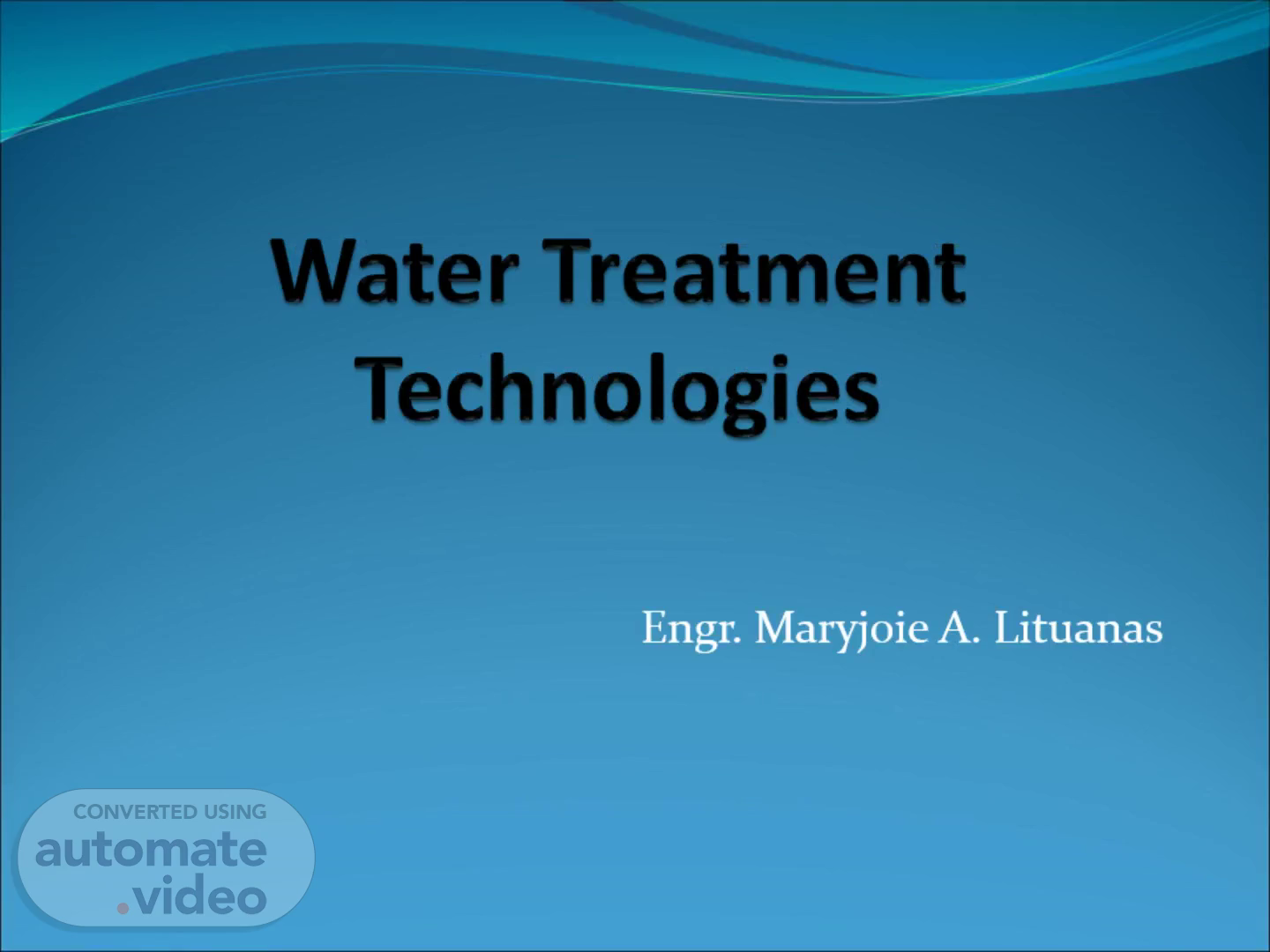
Water Treatment Technologies
Scene 1 (0s)
[Audio] Water Treatment Technologies Engr. Maryjoie A. Lituanas maarmero@dlsud.edu.ph.
Scene 2 (15s)
[Audio] Our planet is shrouded in water, and yet 8 million children under the age of five die yearly from lack of safe water. ----- United Nations Environmental Program.
Scene 3 (28s)
[Audio] Drinking Water Quality - World traveler learns to ask is whether or not the water is safe to drink. - 80% sickness is attributable to inadequate water or sanitation. - estimated ¾ of the population in Asia, Africa, and Latin America lack a safe supply of water for drinking, washing, and sanitation..
Scene 4 (54s)
[Audio] Philippine National Standards for Drinking Water All drinking-water supply under all circumstances ( Level l, ll,lll, Bottled water and Emergency Water Supplies) the E. Coli or Thermotolerant (fecal) coliform bacteria number should be zero per 1000mL.
Scene 5 (1m 17s)
[Audio] Standard Values for Physical and Chemical Quality: Health Significance A. Inorganic Constituents The maximum level (mg/l) is the amount of pollutants in an ecosystem, species or individual can be torelated as we recall the Ecosystem Law of Tolerance. Beyond this threshold level, bioaccumulation or biomagnification principle could be observed which is harmful and not tolerable. Pollution in the environment is then detriimental..
Scene 6 (1m 53s)
[Audio] . Organic Constituents ( Pesticides) These are the Persistent Organic Pollutants, they may live for hundred of years before degradation. These are harmful specially to human health..
Scene 7 (2m 10s)
[Audio] These parameters were discussed in the previous lessons. Maximum level allowed should be strictly implemented by the government..
Scene 8 (2m 34s)
[Audio] WATER TREATMENT SYSTEMS Purpose: to bring raw water up to drinking water quality -treatment required depend to large extent on the quality of the source water..
Scene 9 (2m 50s)
[Audio] The figure shown is the Typical treatment plant for surface water prior to public water supply..
Scene 10 (3m 17s)
[Audio] Screening- to remove relatively large floating and suspended debris Mixing with chemicals -suspended solids to coagulate -more easily settle..
Scene 11 (3m 32s)
[Audio] Coagulation and Flocculation suspended particles of color, turbidity, and bacteria that are too small to settle and cannot be removed by simple screening. Coagulation -gently mixing the water coagulant, - formation of floc. -destabilizes colloidal particles ( 0.001- 1µm).
Scene 12 (3m 59s)
[Audio] Coagulant such as alum ( aluminum sulfate) - formation of a flocculent mass, or floc, - attracting these materials in settling out..
Scene 13 (4m 13s)
[Audio] Sedimentation and Filtration Sedimentation process occur flow is slowed cause the floc to settle in sedimentation basin or clarifier - detention time of 1 t0 10hrs..
Scene 14 (4m 29s)
[Audio] Filtration- tis the process to remove suspended materials Rapid sand filter- is the most widely used filtration units. Sedimentation -flow is slowed cause the floc to settle in sedimentation basin or clarifier - detention time of 1 t0 10hrs..
Scene 15 (4m 51s)
[Audio] Microstraining- is a process designed to reduce the suspended solids including plankton in water. -filtering media : finely woven fabrics of stainless steel Applications: 1) Clarification of clean surface waters low in true color and colloidal turbidity 2)Clarification of waters ahead of slow or rapid sand filters and diatomite filters..
Scene 16 (5m 22s)
[Audio] Disinfection – the final steps to ensure that the water is free of harmful pathogens. Chlorination- destroy the disease producing organisms In nature disinfection occurs by settling out of suspended solids removal of color due to reaction of sunlight death of bacteria because of unfavorable temperature, lack of suitable food sterilizing effect of sunlight..
Scene 17 (5m 55s)
[Audio] Causes of Taste and Odors cause by : oils, minerals, gases, organic matter Can be Control by eliminating the source when possible..
Scene 18 (6m 14s)
[Audio] Method to remove objectionable taste and odors are by Free residual chlorination or super chlorination 2. Aeration or forced-draft degasifier.
Scene 19 (6m 29s)
[Audio] Application of activated carbon Activated carbon ( AC) is a carbon treated to : increase their surface area and increase the ability to adsorb Two basic kinds are a. Granular Activated Carbon( GAC) b. Solid Block Activated Carbon ( SBAC)..
Scene 20 (6m 58s)
[Audio] Activated carbon Contaminant reduction is by two processes: 1. Physical removal- blocking any that are too large to pass through the pores -smaller pores are more effective 2. Adsorption - dissolved contaminants are attracted to and held (adsorbed) on the surface.
Scene 21 (7m 23s)
[Audio] Ozone treatment Ozone- is an unstable gas comprising of three oxygen atom. -is a colorless gas that has an odor similar to the smell of the air after a major thunderstorm..
Scene 22 (7m 39s)
[Audio] The Ozonation Process oxygen into ozone occurs with the use of energy. carried out by an electric discharge field Ozone Generators or by ultraviolet radiation as in UV-type ozone generators O2 are split into individual oxygen atoms: -very unstable -joins with other O2 to form O3..
Scene 23 (8m 6s)
[Audio] Hydrogen Sulfide, Sources and removal Hydrogen sulfide shoes a characteristic of a "rotten egg" Sources: chemical and biological, e.g. wells near oil fields Calcium sulfate containing little or no oxygen will be reduced to sulfides Its Removal by aeration followed by settling an defiltration through an activated carbon pressure filter..
Scene 24 (8m 39s)
[Audio] Iron and Manganese, Occurrence and removal Iron in excess of 0.3 to 0.5 mg/L: stain laundry and plumbing fixtures water to appear rusty. Manganese is predominant, stain will appear black. -can be removed by aeration, sedimentation, the base exchange process, filtration, addition of chemicals.